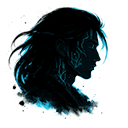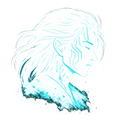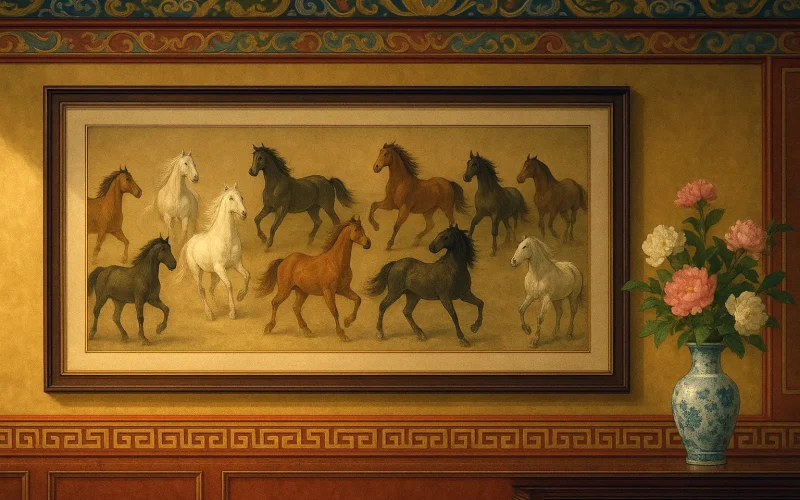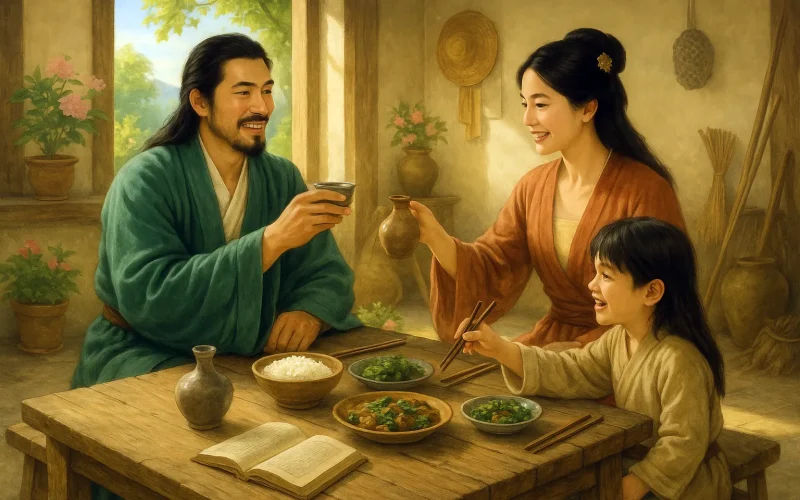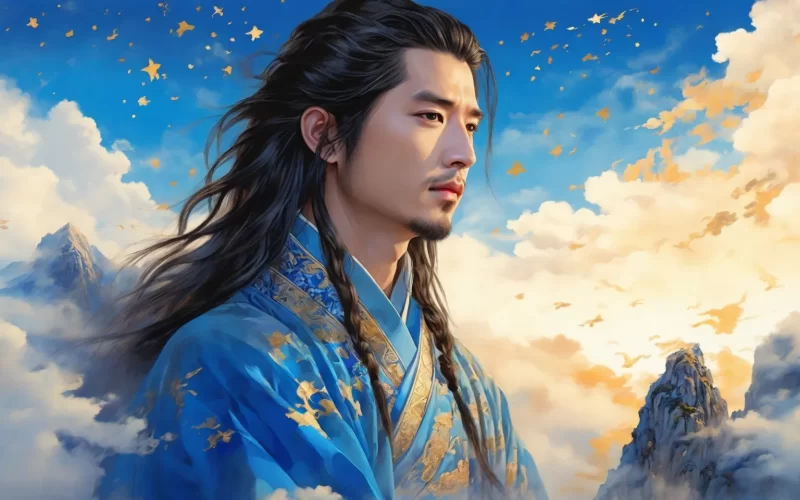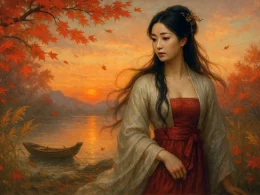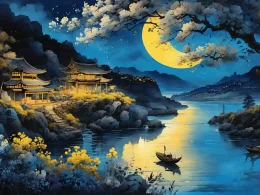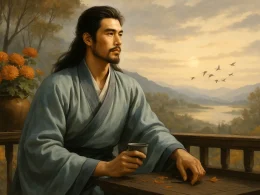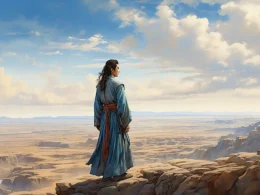Throughout this dynasty no one had painted horses
Like the master-spirit, Prince Jiangdu --
And then to General Cao through his thirty years of fame
The world's gaze turned, for royal steeds.
He painted the late Emperor's luminous white horse.
For ten days the thunder flew over Dragon Lake,
And a pink-agate plate was sent him from the palace-
The talk of the court-ladies, the marvel of all eyes.
The General danced, receiving it in his honoured home
After this rare gift, followed rapidly fine silks
From many of the nobles, requesting that his art
Lend a new lustre to their screens.
...First came the curly-maned horse of Emperor Taizong,
Then, for the Guos, a lion-spotted horse....
But now in this painting I see two horses,
A sobering sight for whosoever knew them.
They are war- horses. Either could face ten thousand.
They make the white silk stretch away into a vast desert.
And the seven others with them are almost as noble
Mist and snow are moving across a cold sky,
And hoofs are cleaving snow-drifts under great trees-
With here a group of officers and there a group of servants.
See how these nine horses all vie with one another-
The high clear glance, the deep firm breath.
...Who understands distinction? Who really cares for art?
You, Wei Feng, have followed Cao; Zhidun preceded him.
...I remember when the late Emperor came toward his Summer Palace,
The procession, in green-feathered rows, swept from the eastern sky --
Thirty thousand horses, prancing, galloping,
Fashioned, every one of them, like the horses in this picture....
But now the Imperial Ghost receives secret jade from the River God,
For the Emperor hunts crocodiles no longer by the streams.
Where you see his Great Gold Tomb, you may hear among the pines
A bird grieving in the wind that the Emperor's horses are gone.
Original Poem:
「韦讽录事宅观曹将军画马图」
杜甫
国初以来画鞍马, 神妙独数江都王。
将军得名三十载, 人间又见真乘黄。
曾貌先帝照夜白, 龙池十日飞霹雳,
内府殷红玛瑙盘, 婕妤传诏才人索。
盘赐将军拜舞归, 轻纨细绮相追飞;
贵戚权门得笔迹, 始觉屏障生光辉。
昔日太宗拳毛騧, 近时郭家狮子花。
今之新图有二马, 复令识者久叹嗟,
此皆骑战一敌万, 缟素漠漠开风沙。
其余七匹亦殊绝, 迥若寒空杂烟雪;
霜蹄蹴踏长楸间, 马官厮养森成列。
可怜九马争神骏, 顾视清高气深稳。
借问苦心爱者谁? 后有韦讽前支盾。
忆昔巡幸新丰宫, 翠花拂天来向东;
腾骧磊落三万匹, 皆与此图筋骨同。
自从献宝朝河宗, 无复射蛟江水中。
君不见,金粟堆前松柏里,龙媒去尽鸟呼风。
Interpretation:
This poem was composed in 767 AD (the second year of the Dali era of Emperor Daizong of the Tang Dynasty), during Du Fu's stay at his thatched cottage in Chengdu. Through the depiction of Cao Ba's painting Nine Horses, the poet praises Cao Ba's exceptional artistic skill while also expressing nostalgia for the grandeur of the High Tang era and lamenting the decline of the times. Cao Ba was a renowned painter during the High Tang period, celebrated for his depictions of horses, and had once enjoyed the favor of Emperor Xuanzong. Du Fu uses this painting as a starting point, employing the imagery of majestic horses to symbolize the rise and fall of the Tang dynasty, conveying profound historical reflection.
First Couplet: "国初以来画鞍马,神妙独数江都王。将军得名三十载,人间又见真乘黄。"
Guó chū yǐ lái huà ān mǎ, shén miào dú shǔ Jiāngdū wáng. Jiāng jūn dé míng sān shí zǎi, rén jiān yòu jiàn zhēn chéng huáng.
Since the founding of the Tang dynasty, Cao Ba of Jiangdu has been unmatched in his divine skill at painting horses. For thirty years, he has been renowned, and now people once again see the legendary "Cheng Huang" brought to life.
The poet begins by highlighting Cao Ba's extraordinary talent. His horses are so lifelike that they seem to resurrect the mythical steed "Cheng Huang," showcasing Cao Ba's unparalleled artistry.
Second Couplet: "曾貌先帝照夜白,龙池十日飞霹雳。内府殷红玛瑙盘,婕妤传诏才人索。"
Céng mào xiān dì zhào yè bái, lóng chí shí rì fēi pī lì. Nèi fǔ yīn hóng mǎ nǎo pán, jié yú chuán zhào cái rén suǒ.
He once painted Emperor Xuanzong's beloved horse, "Zhao Ye Bai," so vividly that it seemed to come alive, startling the dragons in the palace pond and causing thunderstorms for days. The imperial treasury rewarded him with a deep red agate plate, and even palace ladies and courtiers sought his paintings.
This couplet recounts Cao Ba's rise to fame due to his exceptional skill, emphasizing the favor he enjoyed from Emperor Xuanzong. The phrase "causing thunderstorms" vividly conveys the lifelike quality of his paintings, underscoring the awe-inspiring nature of his art.
Third Couplet: "盘赐将军拜舞归,轻纨细绮相追飞。贵戚权门得笔迹,始觉屏障生光辉。"
Pán cì jiāng jūn bài wǔ guī, qīng wán xì qǐ xiāng zhuī fēi. Guì qī quán mén dé bǐ jì, shǐ jué píng zhàng shēng guāng huī.
After receiving the agate plate, Cao Ba bowed in gratitude and returned home, with nobles in fine silks vying for his works. Even the most powerful families felt honored to possess his paintings, which brought splendor to their screens and curtains.
This couplet describes Cao Ba's widespread acclaim, with elites competing for his paintings. Through these details, the poet highlights Cao Ba's extraordinary skill and the high regard in which he was held.
Fourth Couplet: "昔日太宗拳毛騧,近时郭家狮子花。今之新图有二马,复令识者久叹嗟。"
Xī rì Tàizōng quán máo guā, jìn shí Guō jiā shī zi huā. Jīn zhī xīn tú yǒu èr mǎ, fù lìng shí zhě jiǔ tàn jiē.
In the past, he painted Emperor Taizong's "Quan Mao Gua," and more recently, Guo Ziyi's "Lion Flower." His latest work features two more horses, leaving connoisseurs in awe.
The poet uses historical examples of famous horses to emphasize Cao Ba's unparalleled skill, noting that his paintings not only capture the essence of ancient steeds but also vividly depict contemporary horses.
Fifth Couplet: "此皆骑战一敌万,缟素漠漠开风沙。其余七匹亦殊绝,迥若寒空杂烟雪。"
Cǐ jiē qí zhàn yī dí wàn, gǎo sù mò mò kāi fēng shā. Qí yú qī pǐ yì shū jué, jiǒng ruò hán kōng zá yān xuě.
These horses were all warriors on the battlefield, galloping through the misty sands. The other seven horses are equally extraordinary, their forms shimmering like smoke and snow in the cold sky.
This couplet uses dynamic imagery of wind and sand to depict the majestic appearance of the nine horses, further showcasing Cao Ba's exceptional artistry.
Sixth Couplet: "霜蹄蹴踏长楸间,马官厮养森成列。"
Shuāng tí cù tà cháng qiū jiān, mǎ guān sī yǎng sēn chéng liè.
Their hooves clatter on the paths lined with catalpa trees, while grooms and stable hands stand in orderly rows, tending to them.
This couplet portrays the horses' daily life, highlighting their majestic presence and the disciplined atmosphere of the military camp.
Seventh Couplet: "可怜九马争神骏,顾视清高气深稳。借问苦心爱者谁?后有韦讽前支盾。"
Kě lián jiǔ mǎ zhēng shén jùn, gù shì qīng gāo qì shēn wěn. Jiè wèn kǔ xīn ài zhě shuí? Hòu yǒu Wéi Fěng qián Zhī Dùn.
These nine horses are all divine and majestic, their gazes noble and their demeanor steady. Who is the devoted admirer of this masterpiece? It is Wei Feng, surpassing even the famed Zhi Dun of old.
The poet compares Wei Feng to the legendary Zhi Dun, emphasizing Wei Feng's discerning taste in collecting Cao Ba's painting and further elevating the value of Cao Ba's art.
Eighth Couplet: "忆昔巡幸新丰宫,翠花拂天来向东。腾骧磊落三万匹,皆与此图筋骨同。"
Yì xī xún xìng Xīnfēng gōng, cuì huā fú tiān lái xiàng dōng. Téng xiāng lěi luò sān wàn pǐ, jiē yǔ cǐ tú jīn gǔ tóng.
I recall Emperor Xuanzong's grand procession to Xinfeng Palace, with green banners fluttering toward the east. Thirty thousand horses galloped majestically, their forms and spirits no different from those in this painting.
This couplet recalls the splendor of the High Tang era, comparing the thirty thousand horses of the imperial procession to the horses in Cao Ba's painting, further emphasizing the lifelike quality of his art.
Ninth Couplet: "自从献宝朝河宗,无复射蛟江水中。君不见,金粟堆前松柏里,龙媒去尽鸟呼风。"
Zì cóng xiàn bǎo cháo hé zōng, wú fù shè jiāo jiāng shuǐ zhōng. Jūn bù jiàn, jīn sù duī qián sōng bǎi lǐ, lóng méi qù jìn niǎo hū fēng.
Since Emperor Xuanzong's passing and burial at Tailing, the grandeur of the court has faded. Have you not seen? Among the pines and cypresses at Tailing, the once majestic horses are gone, and only birds cry in the wind.
The poet contrasts the decline of Emperor Xuanzong's era and the loss of the imperial horses with the vibrant energy of Cao Ba's painting, expressing deep sorrow over the decline of the Tang dynasty.
Overall Appreciation
This poem revolves around Cao Ba's Nine Horses, praising his extraordinary artistic skill while using the imagery of majestic horses to symbolize the glory of the High Tang era. Through the desolate scene at Emperor Xuanzong's tomb, the poet laments the decline of the Tang dynasty. The poem is grand in tone, with a narrative that rises and falls, blending art, history, and politics into a masterpiece of poetry on paintings.
Writing Characteristics
- Symbolism and Layered Progression: The poet uses Nine Horses as a focal point, gradually unfolding the narrative from Cao Ba's skill to the horses' majesty, and finally to the decline of the Tang dynasty, seamlessly blending art and history.
- Scene and Emotion Intertwined: The poem vividly brings the painting to life while using the horses' rise and fall to reflect the fate of the Tang dynasty, creating a profound and resonant artistic conception.
- Contrast for Emphasis: The vibrant energy of Nine Horses contrasts sharply with the desolation of Emperor Xuanzong's tomb, creating a poignant juxtaposition that evokes deep reflection.
Insights
This poem uses the imagery of horses to express nostalgia for the High Tang era and sorrow over its decline. It reminds us that life, like history, is ever-changing. Whether for individuals or nations, only through continuous striving can we transcend the passage of time and achieve enduring greatness.
Poem translator:
Kiang Kanghu
About the poet
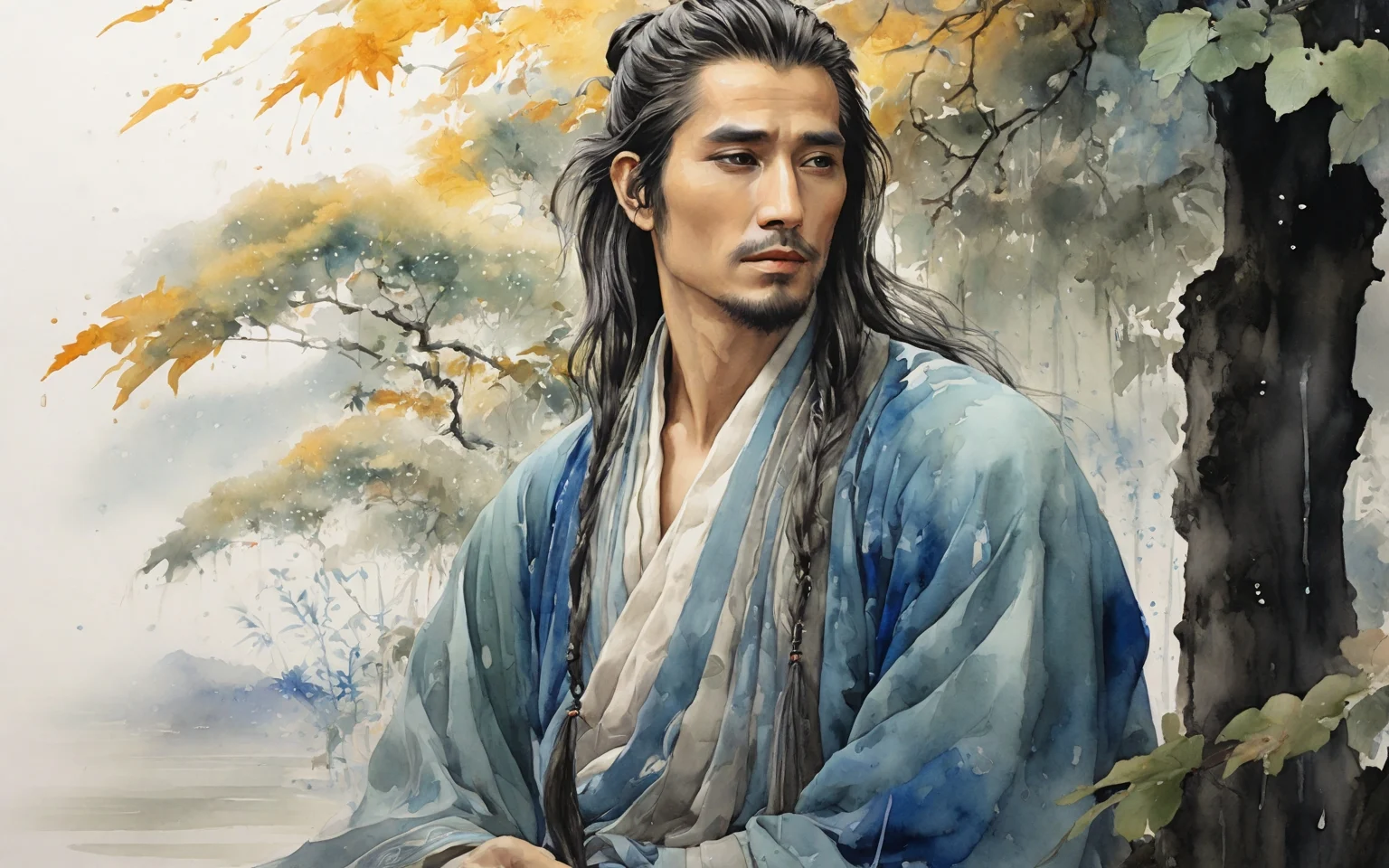
Du Fu (杜甫), 712 - 770 AD, was a great poet of the Tang Dynasty, known as the "Sage of Poetry". Born into a declining bureaucratic family, Du Fu had a rough life, and his turbulent and dislocated life made him keenly aware of the plight of the masses. Therefore, his poems were always closely related to the current affairs, reflecting the social life of that era in a more comprehensive way, with profound thoughts and a broad realm. In his poetic art, he was able to combine many styles, forming a unique style of "profound and thick", and becoming a great realist poet in the history of China.
